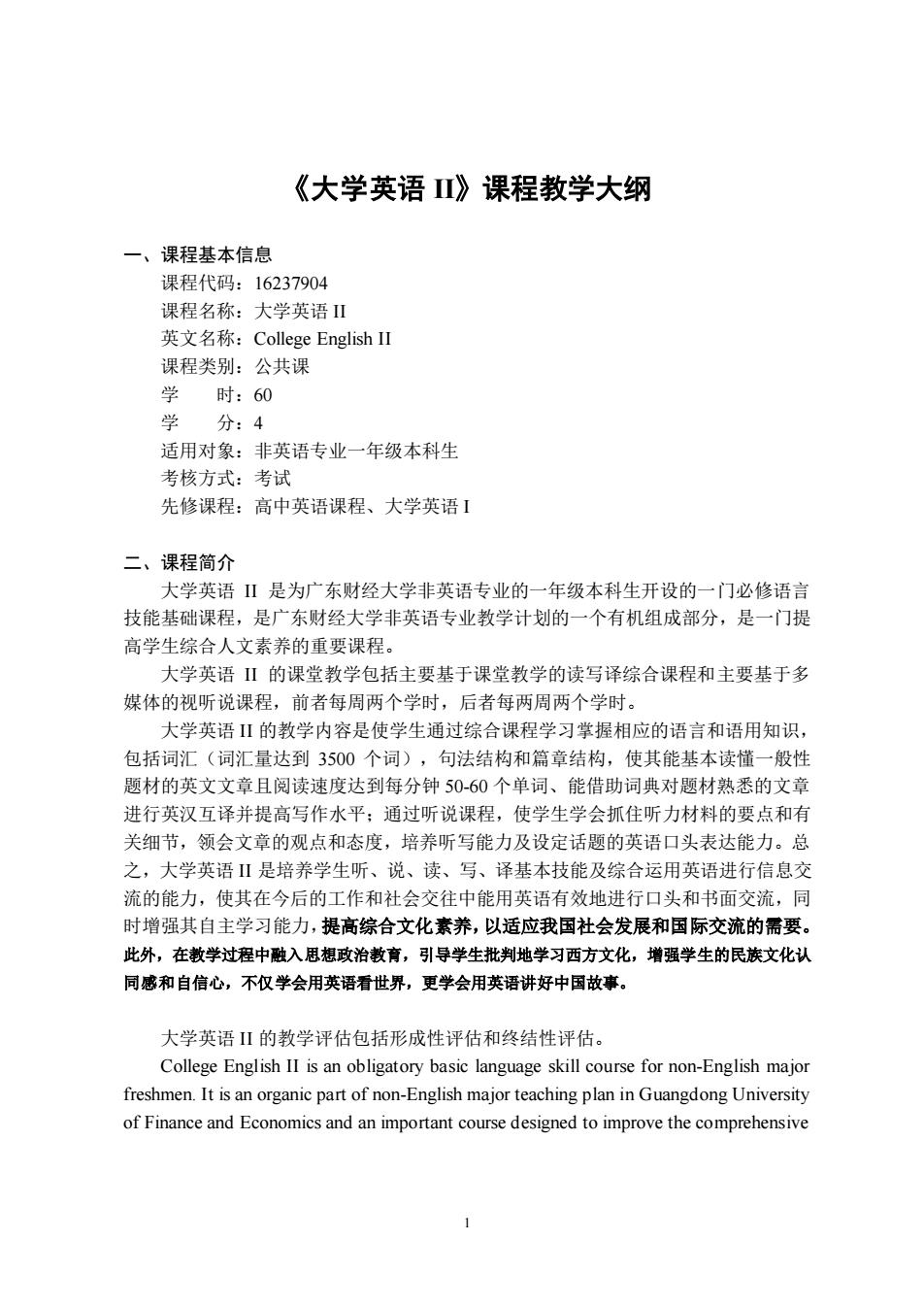
《大学英语Ⅱ》课程教学大纲 一、课程基本信息 课程代码:16237904 课程名称:大学英语Ⅱ 英文名称:College English IⅡ 课程类别:公共课 时:60 学分:4 适用对象:非英语专业一年级本科生 考核方式:考试 先修课程:高中英语课程、大学英语1 二、课程简介 大学英语Ⅱ是为广东财经大学非英语专业的一年级本科生开设的一门必修语言 技能基础课程,是广东财经大学非英语专业教学计划的一个有机组成部分,是一门提 高学生综合人文素养的重要课程。 大学英语Ⅱ的课堂教学包括主要基于课堂教学的读写译综合课程和主要基于多 媒体的视听说课程,前者每周两个学时,后者每两周两个学时。 大学英语Ⅱ的教学内容是使学生通过综合课程学习掌握相应的语言和语用知识, 包括词汇(词汇量达到3500个词),句法结构和篇章结构,使其能基本读懂一般性 题材的英文文章且阅读速度达到每分钟5060个单词、能借助词典对题材熟悉的文章 进行英汉互译并提高写作水平;通过听说课程,使学生学会抓住听力材料的要点和有 关细节,领会文章的观点和态度,培养听写能力及设定话题的英语口头表达能力。总 之,大学英语Ⅱ是培养学生听、说、读、写、译基本技能及综合运用英语进行信息交 流的能力,使其在今后的工作和社会交往中能用英语有效地进行口头和书面交流,同 时增强其自主学习能力,提高综合文化素养,以适应我国社会发展和国际交流的需要。 此外,在教学过程中融入思想政治教育,引导学生批判地学习西方文化,增强学生的民族文化认 同感和自信心,不仅学会用英语看世界,更学会用英语讲好中国故事。 大学英语Ⅱ的教学评估包括形成性评估和终结性评估。 College English II is an obligatory basic language skill course for non-English major freshmen.It is an organic part of non-English major teaching plan in Guangdong University of Finance and Economics and an important course designed to improve the comprehensive
1 《大学英语 II》课程教学大纲 一、课程基本信息 课程代码:16237904 课程名称:大学英语 II 英文名称:College English II 课程类别:公共课 学 时:60 学 分:4 适用对象:非英语专业一年级本科生 考核方式:考试 先修课程:高中英语课程、大学英语 I 二、课程简介 大学英语 II 是为广东财经大学非英语专业的一年级本科生开设的一门必修语言 技能基础课程,是广东财经大学非英语专业教学计划的一个有机组成部分,是一门提 高学生综合人文素养的重要课程。 大学英语 II 的课堂教学包括主要基于课堂教学的读写译综合课程和主要基于多 媒体的视听说课程,前者每周两个学时,后者每两周两个学时。 大学英语 II 的教学内容是使学生通过综合课程学习掌握相应的语言和语用知识, 包括词汇(词汇量达到 3500 个词),句法结构和篇章结构,使其能基本读懂一般性 题材的英文文章且阅读速度达到每分钟 50-60 个单词、能借助词典对题材熟悉的文章 进行英汉互译并提高写作水平;通过听说课程,使学生学会抓住听力材料的要点和有 关细节,领会文章的观点和态度,培养听写能力及设定话题的英语口头表达能力。总 之,大学英语 II 是培养学生听、说、读、写、译基本技能及综合运用英语进行信息交 流的能力,使其在今后的工作和社会交往中能用英语有效地进行口头和书面交流,同 时增强其自主学习能力,提高综合文化素养,以适应我国社会发展和国际交流的需要。 此外,在教学过程中融入思想政治教育,引导学生批判地学习西方文化,增强学生的民族文化认 同感和自信心,不仅学会用英语看世界,更学会用英语讲好中国故事。 大学英语 II 的教学评估包括形成性评估和终结性评估。 College English II is an obligatory basic language skill course for non-English major freshmen. It is an organic part of non-English major teaching plan in Guangdong University of Finance and Economics and an important course designed to improve the comprehensive
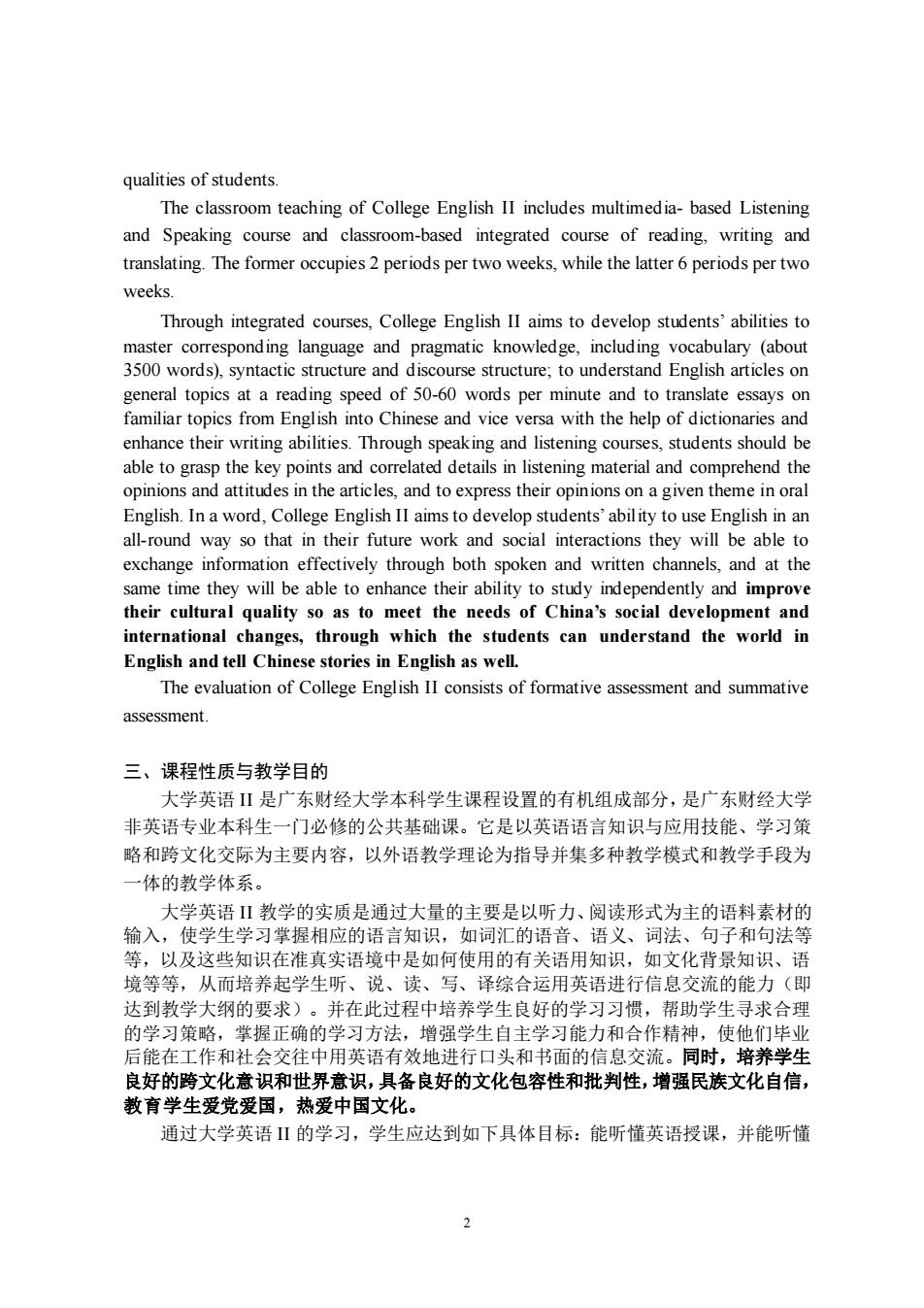
qualities of students. The classroom teaching of College English II includes multimedia-based Listening and Speaking course and classroom-based integrated course of reading,writing and translating.The former occupies 2 periods per two weeks,while the latter 6 periods per two weeks. Through integrated courses.College English II aims to develop students'abilities to master corresponding language and pragmatic knowledge.including vocabulary (about 3500 words).syntactic structure and discourse structure:to understand English articles on general topics a read d of 50-60 words pe slate ess familiar topics from English into Chinese and vice versa with the help of dictionaries and enhance their writing abilities.Through speaking and listening courses,students should be able to grasp the key points and correlated details in listening material and comprehend the opinions and attitudes in the articles,and to express their opinions on a given theme in oral English.Ina word,College English II aims to develop students'ability to use English in a all- ound way so that in their future work and social interactions they will be able to exchange information effectively through both spoken and written channels,and at the same time they will be able to enhance their ability to study independently and improve their cultural quality so as to meet the needs of China's social development and international changes,through which the students can understand the world in English and tell Chinese stories in English as well. The evaluation of College English II consists of formative assessment and summative assessment. 三、课程性质与教学目的 大学英语是广东财经大学本科学生课程设胃的有机组成部分,是广东财经大学 非英语专业本科生一门必修的公共基础课。它是以英语语言知识与应用技能、学习策 略和跨文化交际为主要内容,以外语教学理论为指导并集多种教学模式和教学手段为 体的教学体系。 大学英语Ⅱ教学的实质是通过大量的主要是以听力、阅读形式为主的语料素材的 输入,使学生学习掌握相应的语言知识,如词汇的语音、语义、词法、句子和句法等 等,以及这些知识在准真实语境中是如何使用的有关语用知识,如 化背景知识、语 境等等,从而培养起学生听、说、读 司、译综合运用英语进行信息交流的能力( 达到教学大纲的要求)。并在此过程中培养学生良好的学习习惯,帮助学生寻求合理 的学习策略,掌握正确的学习方法,增强学生自主学习能力和合作精神,使他们毕业 后能在工作和社会交往中用英语有效地进行口头和书面的信息交流。同时,培养学生 良好的畸文化意识和世界意识,具备良好的文化包容性和批判性,增强民族文化自信, 教育学生爱党爱国,热爱中国文化。 通过大学英语Ⅱ的学习,学生应达到如下具体目标:能听懂英语授课,并能听懂 2
2 qualities of students. The classroom teaching of College English II includes multimedia- based Listening and Speaking course and classroom-based integrated course of reading, writing and translating. The former occupies 2 periods per two weeks, while the latter 6 periods per two weeks. Through integrated courses, College English II aims to develop students’ abilities to master corresponding language and pragmatic knowledge, including vocabulary (about 3500 words), syntactic structure and discourse structure; to understand English articles on general topics at a reading speed of 50-60 words per minute and to translate essays on familiar topics from English into Chinese and vice versa with the help of dictionaries and enhance their writing abilities. Through speaking and listening courses, students should be able to grasp the key points and correlated details in listening material and comprehend the opinions and attitudes in the articles, and to express their opinions on a given theme in oral English. In a word, College English II aims to develop students’ ability to use English in an all-round way so that in their future work and social interactions they will be able to exchange information effectively through both spoken and written channels, and at the same time they will be able to enhance their ability to study independently and improve their cultural quality so as to meet the needs of China’s social development and international changes, through which the students can understand the world in English and tell Chinese stories in English as well. The evaluation of College English II consists of formative assessment and summative assessment. 三、课程性质与教学目的 大学英语 II 是广东财经大学本科学生课程设置的有机组成部分,是广东财经大学 非英语专业本科生一门必修的公共基础课。它是以英语语言知识与应用技能、学习策 略和跨文化交际为主要内容,以外语教学理论为指导并集多种教学模式和教学手段为 一体的教学体系。 大学英语 II 教学的实质是通过大量的主要是以听力、阅读形式为主的语料素材的 输入,使学生学习掌握相应的语言知识,如词汇的语音、语义、词法、句子和句法等 等,以及这些知识在准真实语境中是如何使用的有关语用知识,如文化背景知识、语 境等等,从而培养起学生听、说、读、写、译综合运用英语进行信息交流的能力(即 达到教学大纲的要求)。并在此过程中培养学生良好的学习习惯,帮助学生寻求合理 的学习策略,掌握正确的学习方法,增强学生自主学习能力和合作精神,使他们毕业 后能在工作和社会交往中用英语有效地进行口头和书面的信息交流。同时,培养学生 良好的跨文化意识和世界意识,具备良好的文化包容性和批判性,增强民族文化自信, 教育学生爱党爱国,热爱中国文化。 通过大学英语 II 的学习,学生应达到如下具体目标:能听懂英语授课,并能听懂
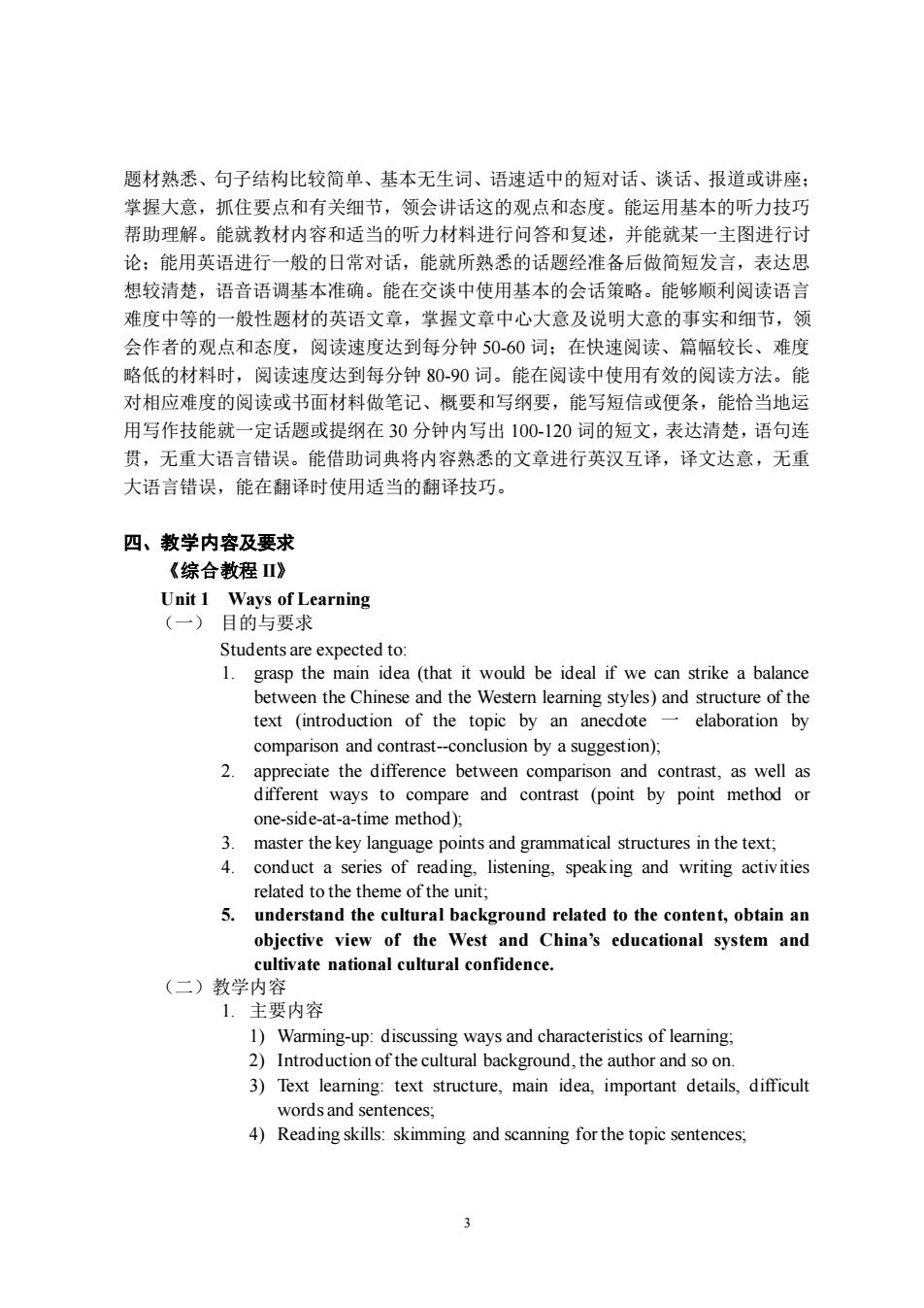
题材熟悉、句子结构比较简单、基本无生词、语速适中的短对话、谈话、报道或讲座: 掌握大意,抓住要点和有关细节,领会讲话这的观点和态度。能运用基本的听力技巧 帮助理解。能就教材内容和适当的听力材料进行问答和复述,并能就某一主图进行讨 论:能用英语进行一般的日常对话,能就所熟悉的话题经准备后做简短发言,表达思 想较清楚,语音语调基本准确。能在交谈中使用基本的会话策略。能够顺利阅读语言 难度中等的一般性题材的英语文章,掌握文章中心大意及说明大意的事实和细节,领 会作者的观点和态度,阅读速度达到每分钟5060词:在快速阅读、篇幅较长,难度 略低的材料时,阅读速度达到每分钟80-90词。能在阅读中使用有效的阅读方法。能 对相应难度的阅读或书面材料做笔记、概要和写纲要,能写短信或便条,能恰当地运 用写作技能就一定话题或提纲在30分钟内写出100-120词的短文,表达清楚,语句连 贯,无重大语言错误。能借助词典将内容熟悉的文章进行英汉互译,译文达意,无重 大语言错误,能在翻译时使用适当的翻译技巧。 四、教学内容及要求 《综合教程》 Unit 1 Ways of Learning (一)目的与要求 Studentsare expected grasp the main idea (that it would be ideal if we can strike a balance between the Chinese and the Western learning styles)and structure of the text (introduction of the topic by an anecdote elaboration by comparison and contrast--conclusion by a suggestion), 2. and contrast,as a ways to compare an contrast (point by point method or one-side-at-a-time method ) 3.master the key language points and grammatical structures in the text; 4.conduct a series of reading.listening.speaking and writing activities related to the theme of the uni 5. understand the cultural background related to the content,obtain an objective view of the West and China's educational system and cultivate national cultural confidence. (二)教学内容 1.主要内容 )Warmin up:discussing ways and characteristics of eain 2)Introduction of the cultural background,the author and soon 3)Text learning:text structure.main idea.important details.difficult words and sentences 4)Reading skills:skimming and scanning for the topic sentences 3
3 题材熟悉、句子结构比较简单、基本无生词、语速适中的短对话、谈话、报道或讲座; 掌握大意,抓住要点和有关细节,领会讲话这的观点和态度。能运用基本的听力技巧 帮助理解。能就教材内容和适当的听力材料进行问答和复述,并能就某一主图进行讨 论;能用英语进行一般的日常对话,能就所熟悉的话题经准备后做简短发言,表达思 想较清楚,语音语调基本准确。能在交谈中使用基本的会话策略。能够顺利阅读语言 难度中等的一般性题材的英语文章,掌握文章中心大意及说明大意的事实和细节,领 会作者的观点和态度,阅读速度达到每分钟 50-60 词;在快速阅读、篇幅较长、难度 略低的材料时,阅读速度达到每分钟 80-90 词。能在阅读中使用有效的阅读方法。能 对相应难度的阅读或书面材料做笔记、概要和写纲要,能写短信或便条,能恰当地运 用写作技能就一定话题或提纲在 30 分钟内写出 100-120 词的短文,表达清楚,语句连 贯,无重大语言错误。能借助词典将内容熟悉的文章进行英汉互译,译文达意,无重 大语言错误,能在翻译时使用适当的翻译技巧。 四、教学内容及要求 《综合教程 II》 Unit 1 Ways of Learning (一) 目的与要求 Students are expected to: 1. grasp the main idea (that it would be ideal if we can strike a balance between the Chinese and the Western learning styles) and structure of the text (introduction of the topic by an anecdote 一 elaboration by comparison and contrast--conclusion by a suggestion); 2. appreciate the difference between comparison and contrast, as well as different ways to compare and contrast (point by point method or one-side-at-a-time method); 3. master the key language points and grammatical structures in the text; 4. conduct a series of reading, listening, speaking and writing activities related to the theme of the unit; 5. understand the cultural background related to the content, obtain an objective view of the West and China’s educational system and cultivate national cultural confidence. (二)教学内容 1. 主要内容 1) Warming-up: discussing ways and characteristics of learning; 2) Introduction of the cultural background, the author and so on. 3) Text learning: text structure, main idea, important details, difficult words and sentences; 4) Reading skills: skimming and scanning for the topic sentences;
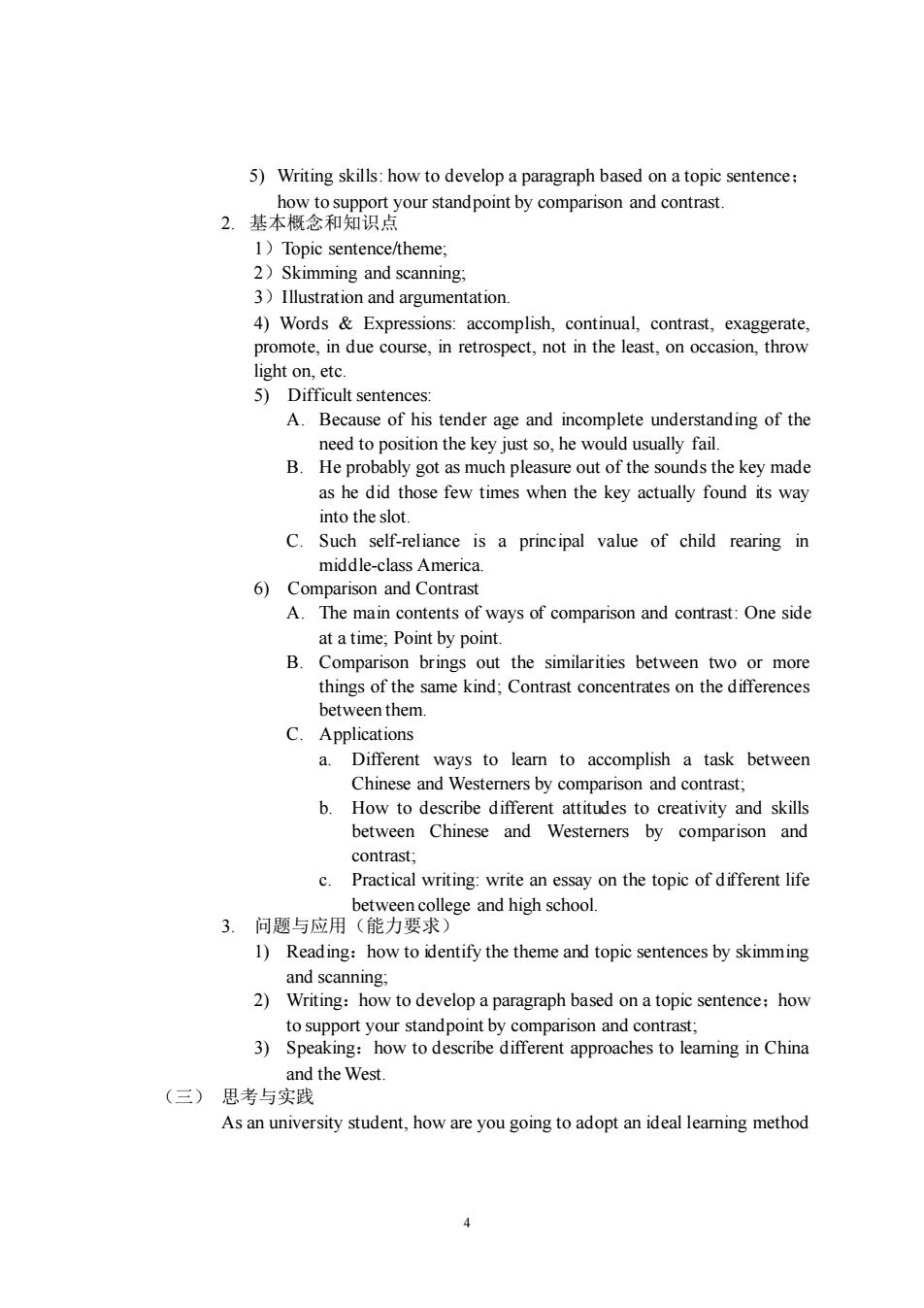
5)Writing skills:how to develop a paragraph based on a topic sentence: 2基本9和粥9our6 bomp 1)Topic sentence/theme. 2) imming and scanning 3)Illustration and argumentation 4)Words Expressions:accomplish,continual,contrast,exaggerate, promote,in due course,in retrospect,not in the least,on occasion,throw light on etc 5)Difficult sentences A.Because of his tender age and incomplete understanding of the need to position the key just so,he would usually fail. B.He probably got as much pleasure out of the sounds the key made as he did those few times when the key actually found its way into the slot. C. Such self-reliance is a principal value of child rearing in middle-class America 6)Comparison and Contrast A.The main contents of ways of comparison and contrast:One side atatime:Point by point. B. n brings out the similarities between two or more things of the same kind;Contrast concentrates on the differences between them C.Applications Different nese and Westerners by comparison and contr accomplish a task between 6 How to describe different attitudes to creativity and skills between Chinese and Westerners by comparison and contrast: c. Practical writing:write an essay on the topic of different life 3.问恩与应用能要 lege and high school. 1)Reading:how to identify the theme and topic sentences by skimming and scanning: 2)Writing:how to develop a paragraph based on a topic sentence:how nparison and contrast. ibe diffe approaches to leaming in China and the West (三)思考与实践 As an university student,how are you going to adopt an ideal learning method 4
4 5) Writing skills: how to develop a paragraph based on a topic sentence; how to support your standpoint by comparison and contrast. 2. 基本概念和知识点 1)Topic sentence/theme; 2)Skimming and scanning; 3)Illustration and argumentation. 4) Words & Expressions: accomplish, continual, contrast, exaggerate, promote, in due course, in retrospect, not in the least, on occasion, throw light on, etc. 5) Difficult sentences: A. Because of his tender age and incomplete understanding of the need to position the key just so, he would usually fail. B. He probably got as much pleasure out of the sounds the key made as he did those few times when the key actually found its way into the slot. C. Such self-reliance is a principal value of child rearing in middle-class America. 6) Comparison and Contrast A. The main contents of ways of comparison and contrast: One side at a time; Point by point. B. Comparison brings out the similarities between two or more things of the same kind; Contrast concentrates on the differences between them. C. Applications a. Different ways to learn to accomplish a task between Chinese and Westerners by comparison and contrast; b. How to describe different attitudes to creativity and skills between Chinese and Westerners by comparison and contrast; c. Practical writing: write an essay on the topic of different life between college and high school. 3. 问题与应用(能力要求) 1) Reading:how to identify the theme and topic sentences by skimming and scanning; 2) Writing:how to develop a paragraph based on a topic sentence;how to support your standpoint by comparison and contrast; 3) Speaking:how to describe different approaches to learning in China and the West. (三) 思考与实践 As an university student, how are you going to adopt an ideal learning method
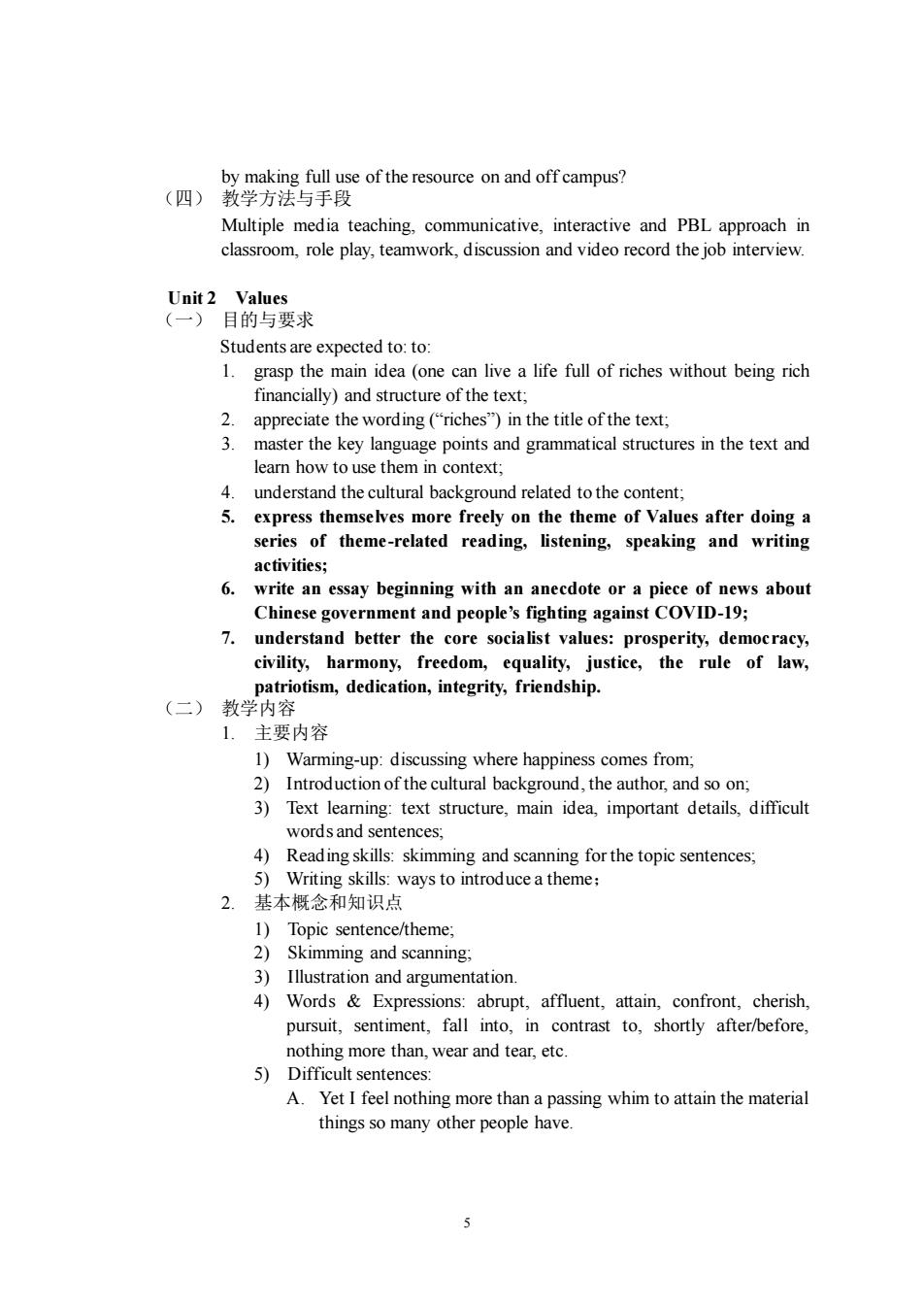
by making full use of the resource on and off campus? (四)教学方法与手段 Mutipe media teaching.and PBLapproach in classroom,ole play,teamwork,discussion and video record the job interview Unit 2 Values (一)目的与要求 Students are expected to:to: grasp the main idea (one can live a life full of riches without being rich i ncially)and str cture of the text appreciate the wording ("riches)in the title of the text: 3. master the key language points and grammatical structures in the text and learn how to use them in context 5. express themselves more freely on the theme of Values after doing a series of theme-related reading,listening,speaking and writing activities: 6.write an essay beginning with an anecdote or a piece of news about Chinese government and people's fighting against COVID-19; 7. understand better the cor socialist values prosp rity,democracy. civility,harmony,freedom,equality,justice,the rule of law, patriotism,dedication,integrity,friendship. (二)教学内容 1主要内容 -NR。ebee网 ing where happinessc comes from Intro 3)Text learning:text structure,main idea,important details,difficult words and sentences: 4)Reading skills:skimming and scanning for the topic sentences, 5)Writing skills:ways to introduce a theme: 2.基本概念和知识点 1)Topic sentence/theme; 2)Skimming and scanning: 3)Illustration and argumentation. 4)Words &Expressions:abrupt,affluent,attain,confront,cherish. uit ent,fall int contrast to,shortly afte nothing more than,wear and tear,etc. 5)Difficult sentences: A.Yet I feel nothing more than a passing whim to attain the material things so many other people have. 5
5 by making full use of the resource on and off campus? (四) 教学方法与手段 Multiple media teaching, communicative, interactive and PBL approach in classroom, role play, teamwork, discussion and video record the job interview. Unit 2 Values (一) 目的与要求 Students are expected to: to: 1. grasp the main idea (one can live a life full of riches without being rich financially) and structure of the text; 2. appreciate the wording (“riches”) in the title of the text; 3. master the key language points and grammatical structures in the text and learn how to use them in context; 4. understand the cultural background related to the content; 5. express themselves more freely on the theme of Values after doing a series of theme-related reading, listening, speaking and writing activities; 6. write an essay beginning with an anecdote or a piece of news about Chinese government and people’s fighting against COVID-19; 7. understand better the core socialist values: prosperity, democracy, civility, harmony, freedom, equality, justice, the rule of law, patriotism, dedication, integrity, friendship. (二) 教学内容 1. 主要内容 1) Warming-up: discussing where happiness comes from; 2) Introduction of the cultural background, the author, and so on; 3) Text learning: text structure, main idea, important details, difficult words and sentences; 4) Reading skills: skimming and scanning for the topic sentences; 5) Writing skills: ways to introduce a theme; 2. 基本概念和知识点 1) Topic sentence/theme; 2) Skimming and scanning; 3) Illustration and argumentation. 4) Words & Expressions: abrupt, affluent, attain, confront, cherish, pursuit, sentiment, fall into, in contrast to, shortly after/before, nothing more than, wear and tear, etc. 5) Difficult sentences: A. Yet I feel nothing more than a passing whim to attain the material things so many other people have